engine CITROEN C5 AIRCROSS 2020 Handbook (in English)
[x] Cancel search | Manufacturer: CITROEN, Model Year: 2020, Model line: C5 AIRCROSS, Model: CITROEN C5 AIRCROSS 2020Pages: 292, PDF Size: 8.59 MB
Page 180 of 292
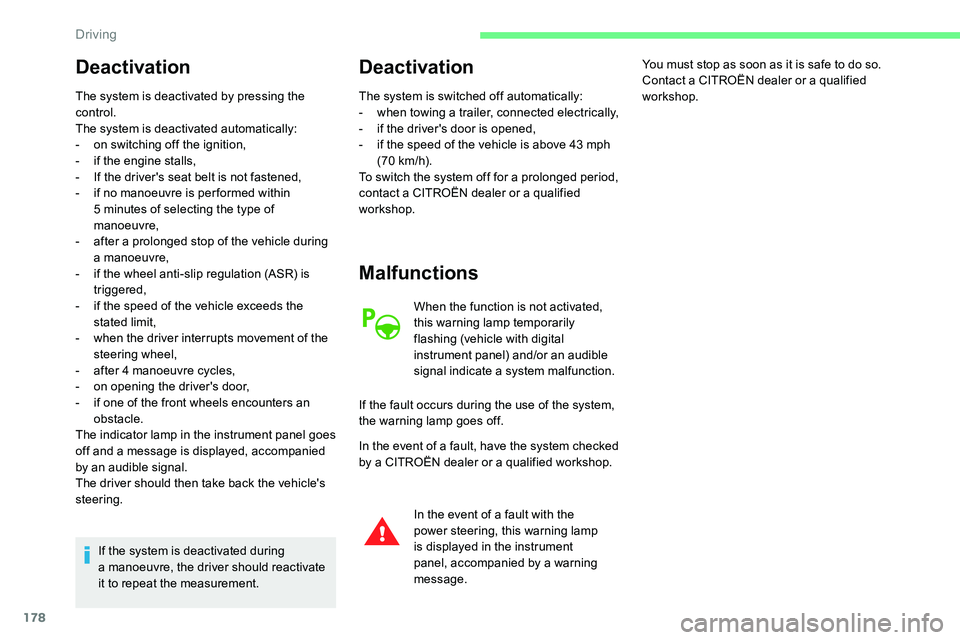
178
Deactivation
The system is deactivated by pressing the
control.
The system is deactivated automatically:
-
o
n switching off the ignition,
-
i
f the engine stalls,
-
I
f the driver's seat belt is not fastened,
-
i
f no manoeuvre is per formed within
5
minutes of selecting the type of
manoeuvre,
-
a
fter a prolonged stop of the vehicle during
a
manoeuvre,
-
i
f the wheel anti-slip regulation (ASR) is
triggered,
-
i
f the speed of the vehicle exceeds the
stated limit,
-
w
hen the driver interrupts movement of the
steering wheel,
-
a
fter 4 manoeuvre cycles,
-
o
n opening the driver's door,
-
i
f one of the front wheels encounters an
obstacle.
The indicator lamp in the instrument panel goes
off and a
message is displayed, accompanied
by an audible signal.
The driver should then take back the vehicle's
steering.
If the system is deactivated during
a
manoeuvre, the driver should reactivate
it to repeat the measurement.
Deactivation
The system is switched off automatically:
- w hen towing a trailer, connected electrically,
-
i
f the driver's door is opened,
-
i
f the speed of the vehicle is above 43 mph
(70
km/h).
To switch the system off for a
prolonged period,
contact a
CITROËN dealer or a qualified
workshop.
Malfunctions
When the function is not activated,
this warning lamp temporarily
flashing (vehicle with digital
instrument panel) and/or an audible
signal indicate a
s
ystem malfunction.
If the fault occurs during the use of the system,
the warning lamp goes off.
In the event of a
fault, have the system checked
by a
CITROËN dealer or a qualified workshop.
In the event of a
fault with the
power steering, this warning lamp
is displayed in the instrument
panel, accompanied by a
warning
message. You must stop as soon as it is safe to do so.
Contact a
CITROËN dealer or a qualified
workshop.
Driving
Page 181 of 292

FILL UP WITH
CONFIDENCE
WITH TOTAL QUARTZ
LUBRICANTS
For more than 45 years, TOTAL
and CITROËN have shared common
values: excellence, creativity and
technological innovation.
It is in this same spirit that TOTAL
has developed a
range
of TOTAL
QUARTZ lubricants adapted to
CITROËN engines, making them even
more fuel efficient and protective of
the environment.
TOTAL and CITROËN test the
reliability and the performance of their
products during motorsport races in
extreme conditions.
Choose TOTAL QUARTZ lubricants
to maintain your vehicle, this is your
assurance of optimum durability
and performance from your engine.
Page 182 of 292
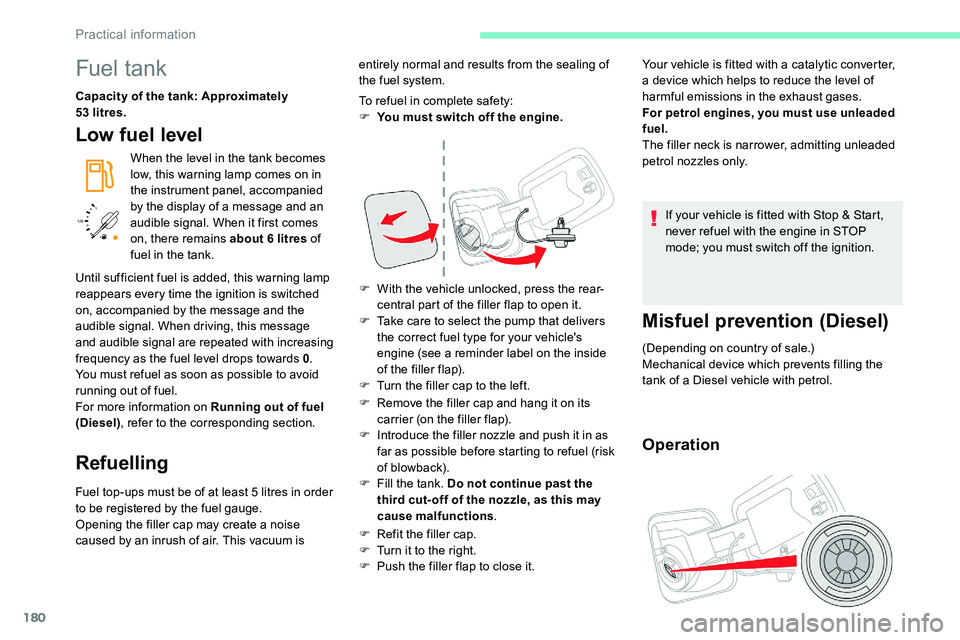
180
/2
1 1
Fuel tank
Capacity of the tank: Approximately
53
litres.
Low fuel level
When the level in the tank becomes
low, this warning lamp comes on in
the instrument panel, accompanied
by the display of a
message and an
audible signal. When it first comes
on, there remains about 6
litres of
fuel in the tank.
Refuelling
Fuel top-ups must be of at least 5 litres in order
t o be registered by the fuel gauge.
Opening the filler cap may create a
noise
caused by an inrush of air. This vacuum is To refuel in complete safety:
F
Y
ou must switch off the engine.
F
W
ith the vehicle unlocked, press the rear-
central part of the filler flap to open it.
F
T
ake care to select the pump that delivers
the correct fuel type for your vehicle's
engine (see a reminder label on the inside
of the filler flap).
F
T
urn the filler cap to the left.
F
R
emove the filler cap and hang it on its
carrier (on the filler flap).
F
I
ntroduce the filler nozzle and push it in as
far as possible before starting to refuel (risk
of blowback).
F F ill the tank. Do not continue past the
third cut- off of the nozzle, as this may
cause malfunctions .
F
R
efit the filler cap.
F
T
urn it to the right.
F
P
ush the filler flap to close it.Your vehicle is fitted with a
catalytic converter,
a device which helps to reduce the level of
harmful emissions in the exhaust gases.
For petrol engines, you must use unleaded
fuel.
The filler neck is narrower, admitting unleaded
petrol nozzles only.
If your vehicle is fitted with Stop & Start,
never refuel with the engine in STOP
mode; you must switch off the ignition.
Misfuel prevention (Diesel)
(Depending on country of sale.)
Mechanical device which prevents filling the
tank of a Diesel vehicle with petrol.
Operation
Until sufficient fuel is added, this warning lamp
reappears every time the ignition is switched
on, accompanied by the message and the
audible signal. When driving, this message
and audible signal are repeated with increasing
frequency as the fuel level drops towards 0 .
You must refuel as soon as possible to avoid
running out of fuel.
For more information on Running out of fuel
(Diesel) , refer to the corresponding section. entirely normal and results from the sealing of
the fuel system.
Practical information
Page 183 of 292
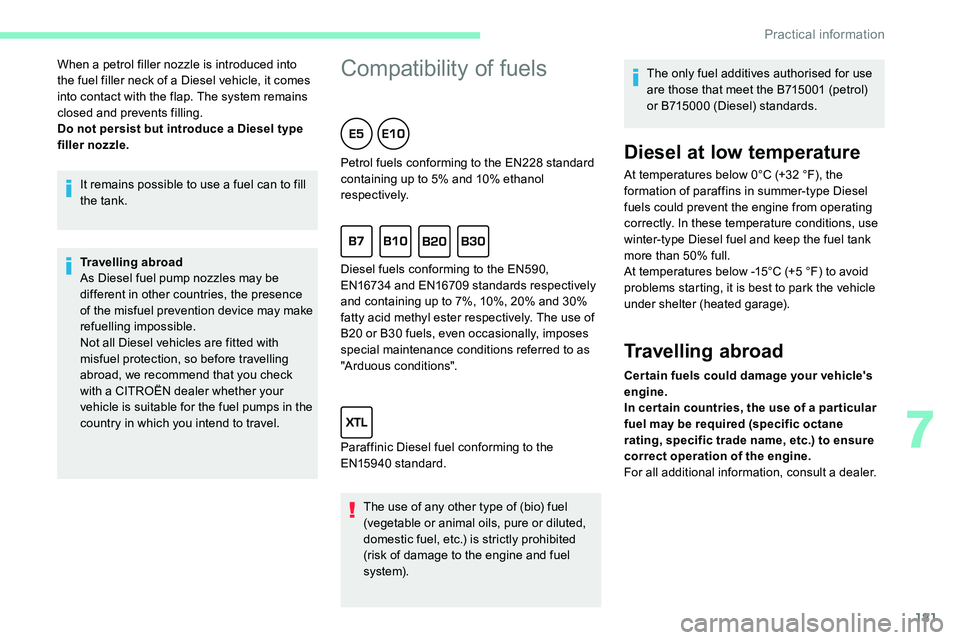
181
It remains possible to use a fuel can to fill
t he tank.
Travelling abroad
As Diesel fuel pump nozzles may be
different in other countries, the presence
of the misfuel prevention device may make
refuelling impossible.
Not all Diesel vehicles are fitted with
misfuel protection, so before travelling
abroad, we recommend that you check
with a
CITROËN dealer whether your
vehicle is suitable for the fuel pumps in the
country in which you intend to travel.
When a
petrol filler nozzle is introduced into
the fuel filler neck of a Diesel vehicle, it comes
into contact with the flap. The system remains
closed and prevents filling.
Do not persist but introduce a Diesel type
filler nozzle.
Compatibility of fuels
The use of any other type of (bio) fuel
(vegetable or animal oils, pure or diluted,
domestic fuel, etc.) is strictly prohibited
(risk of damage to the engine and fuel
syste m). The only fuel additives authorised for use
are those that meet the B715001 (petrol)
or B715000 (Diesel) standards.
Petrol fuels conforming to the EN228 standard
containing up to 5% and 10% ethanol
respectively.
Diesel fuels conforming to the EN590,
EN16734 and EN16709 standards respectively
and containing up to 7%, 10%, 20% and 30%
fatty acid methyl ester respectively. The use of
B20
or B30 fuels, even occasionally, imposes
special maintenance conditions referred to as
"Arduous conditions".
Paraffinic Diesel fuel conforming to the
EN15940
standard.
Diesel at low temperature
At temperatures below 0°C (+32 °F), the
formation of paraffins in summer-type Diesel
fuels could prevent the engine from operating
correctly. In these temperature conditions, use
winter-type Diesel fuel and keep the fuel tank
more than 50% full.
At temperatures below -15°C (+5 °F) to avoid
problems starting, it is best to park the vehicle
under shelter (heated garage).
Travelling abroad
Cer tain fuels could damage your vehicle's
engine.
In cer tain countries, the use of a
par ticular
fuel may be required (specific octane
rating, specific trade name, etc.) to ensure
correct operation of the engine.
For all additional information, consult a
dealer.
7
Practical information
Page 184 of 292
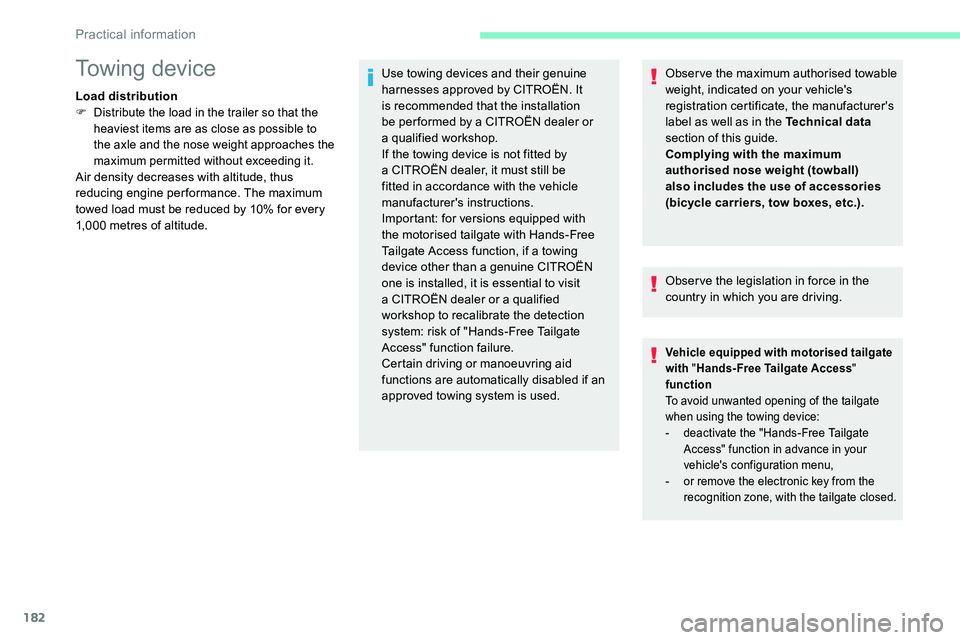
182
Obser ve the maximum authorised towable
weight, indicated on your vehicle's
registration certificate, the manufacturer's
label as well as in the Technical data
section of this guide.
Complying with the maximum
authorised nose weight (towball)
also includes the use of accessories
(bicycle carriers, tow boxes, etc.).
Obser ve the legislation in force in the
country in which you are driving.
Vehicle equipped with motorised tailgate
with " Hands-Free Tailgate Access "
function
To avoid unwanted opening of the tailgate
when using the towing device:
-
d
eactivate the "Hands-Free Tailgate
Access" function in advance in your
vehicle's configuration menu,
-
o
r remove the electronic key from the
recognition zone, with the tailgate closed.
Towing device
Load distribution
F Distribute the load in the trailer so that the
heaviest items are as close as possible to
the axle and the nose weight approaches the
maximum permitted without exceeding it.
Air density decreases with altitude, thus
reducing engine performance. The maximum
towed load must be reduced by 10% for every
1,000
metres of altitude. Use towing devices and their genuine
harnesses approved by CITROËN. It
is recommended that the installation
be per formed by a
CITROËN dealer or
a
qualified workshop.
If the towing device is not fitted by
a CITROËN dealer, it must still be
fitted in accordance with the vehicle
manufacturer's instructions.
Important: for versions equipped with
the motorised tailgate with Hands-Free
Tailgate Access function, if a
towing
device other than a
genuine CITROËN
one is installed, it is essential to visit
a
CITROËN dealer or a qualified
workshop to recalibrate the detection
system: risk of "Hands-Free Tailgate
Access" function failure.
Certain driving or manoeuvring aid
functions are automatically disabled if an
approved towing system is used.
Practical information
Page 188 of 292
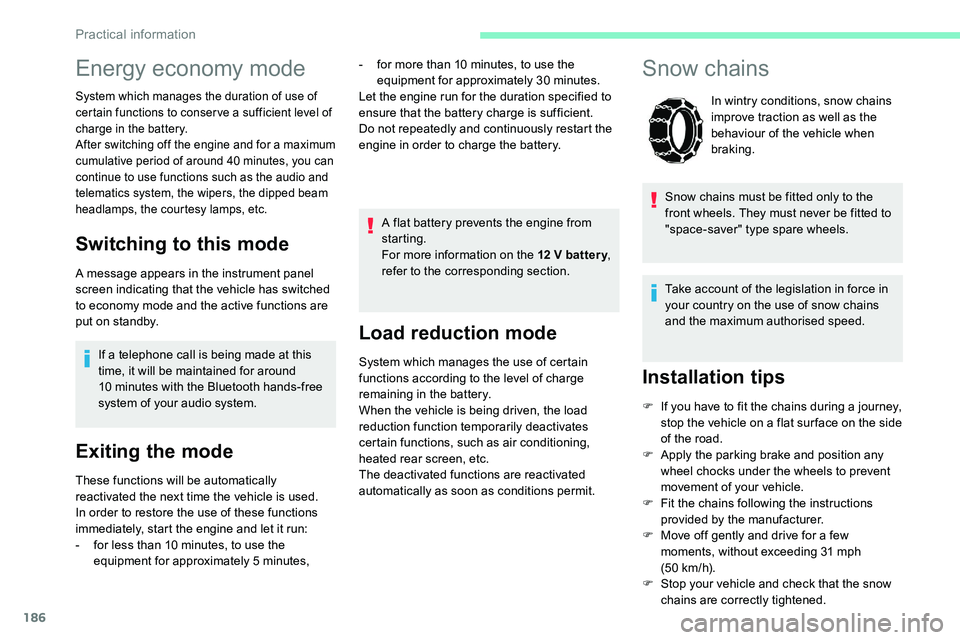
186
Load reduction mode
System which manages the use of certain
functions according to the level of charge
remaining in the battery.
When the vehicle is being driven, the load
reduction function temporarily deactivates
certain functions, such as air conditioning,
heated rear screen, etc.
The deactivated functions are reactivated
automatically as soon as conditions permit.
Snow chains
In wintry conditions, snow chains
improve traction as well as the
behaviour of the vehicle when
braking.
Snow chains must be fitted only to the
front wheels. They must never be fitted to
"space-saver" type spare wheels.
Take account of the legislation in force in
your country on the use of snow chains
and the maximum authorised speed.
Installation tips
F If you have to fit the chains during a journey,
stop the vehicle on a flat sur face on the side
of the road.
F
A
pply the parking brake and position any
wheel chocks under the wheels to prevent
movement of your vehicle.
F
F
it the chains following the instructions
provided by the manufacturer.
F
M
ove off gently and drive for a few
moments, without exceeding 31
mph
(50
km/h).
F
S
top your vehicle and check that the snow
chains are correctly tightened.
Energy economy mode
System which manages the duration of use of
certain functions to conser ve a sufficient level of
charge in the battery.
After switching off the engine and for a
maximum
cumulative period of around 40
minutes, you can
continue to use functions such as the audio and
telematics system, the wipers, the dipped beam
headlamps, the courtesy lamps, etc.
Switching to this mode
A message appears in the instrument panel
screen indicating that the vehicle has switched
to economy mode and the active functions are
put on standby.
If a
telephone call is being made at this
time, it will be maintained for around
10
minutes with the Bluetooth hands-free
system of your audio system.
Exiting the mode
These functions will be automatically
reactivated the next time the vehicle is used.
In order to restore the use of these functions
immediately, start the engine and let it run:
-
f
or less than 10 minutes, to use the
equipment for approximately 5
minutes,A flat battery prevents the engine from
starting.
For more information on the 12
V batter y
,
refer to the corresponding section.
-
f
or more than 10 minutes, to use the
equipment for approximately 30
minutes.
Let the engine run for the duration specified to
ensure that the battery charge is sufficient.
Do not repeatedly and continuously restart the
engine in order to charge the battery.
Practical information
Page 190 of 292

188
Bonnet
The location of the interior bonnet release
lever prevents opening the bonnet when
the left-hand front door is shut.When the engine is hot, handle the
exterior safety catch and the bonnet
stay with care (risk of burns), using the
protected area.
When the bonnet is open, take care not to
damage the safety catch.
Do not open the bonnet under very windy
conditions.
The cooling fan may star t after
switching off the engine: take care
with articles and clothing that might be
caught by the fan blades.
Opening
F Open the left-hand front door.
Before doing anything under the bonnet,
deactivate the Stop & Start system to
avoid the risk of injury related to an
automatic change to START mode. F
P
ull the release lever, located at the bottom
of the door aperture, towards you.
Version without longitudinal
bars
The roof bar fixings include a lug to be fitted
i nto the hole at each fixing point.
Version with longitudinal
bars
You must fit the transverse bars to the
longitudinal bars at the engraved markings on
the longitudinal bars.
To install the roof bars, you must secure them
only to the four fixing points on the roof frame.
These points are concealed by the vehicle's
doors when they are closed.
Practical information
Page 191 of 292
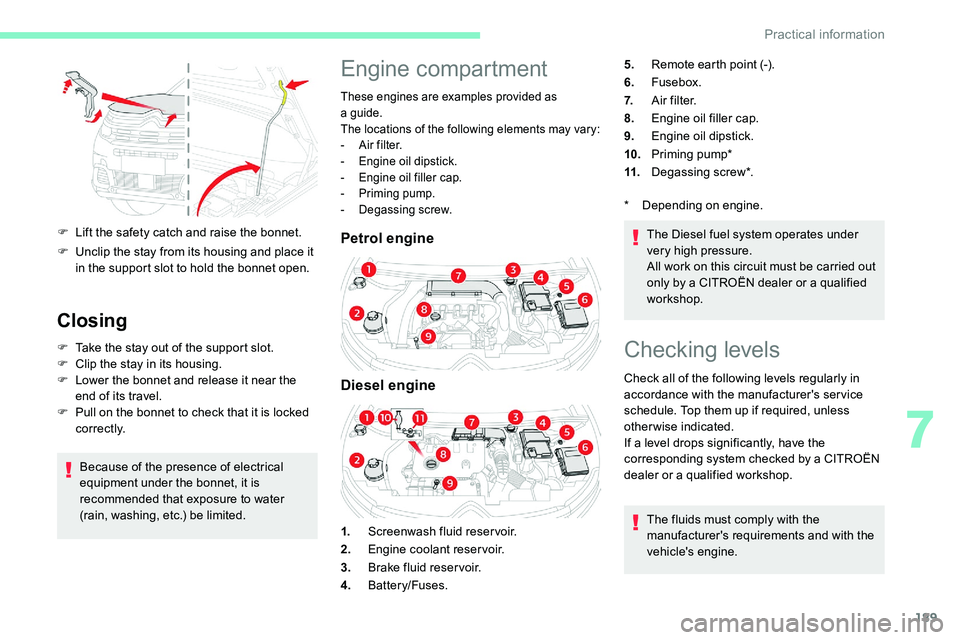
189
F Lift the safety catch and raise the bonnet.
F
U
nclip the stay from its housing and place it
in the support slot to hold the bonnet open.
Closing
F Take the stay out of the support slot.
F C lip the stay in its housing.
F
L
ower the bonnet and release it near the
end of its travel.
F
P
ull on the bonnet to check that it is locked
c o r r e c t l y.
Because of the presence of electrical
equipment under the bonnet, it is
recommended that exposure to water
(rain, washing, etc.) be limited.
Engine compartment
These engines are examples provided as
a guide.
The locations of the following elements may vary:
-
A
ir filter.
-
E
ngine oil dipstick.
-
E
ngine oil filler cap.
-
P
riming pump.
-
D
egassing screw.
Petrol engine
Diesel engine
1. Screenwash fluid reservoir.
2. Engine coolant reservoir.
3. Brake fluid reser voir.
4. Battery/Fuses. The Diesel fuel system operates under
very high pressure.
All work on this circuit must be carried out
only by a
CITROËN dealer or a qualified
workshop.
5.
Remote earth point (-).
6. Fusebox.
7. A i r f i l t e r.
8. Engine oil filler cap.
9. Engine oil dipstick.
10. Priming pump*
11. Degassing screw*.
*
D
epending on engine.
Checking levels
Check all of the following levels regularly in
accordance with the manufacturer's service
schedule. Top them up if required, unless
otherwise indicated.
If a
level drops significantly, have the
corresponding system checked by a
CITROËN
dealer or a
qualified workshop.
The fluids must comply with the
manufacturer's requirements and with the
vehicle's engine.
7
Practical information
Page 192 of 292

190
Check using the dipstick
The location of the dipstick is shown in the
corresponding underbonnet layout view.
F
T
ake the dipstick by its coloured grip and
pull it out completely.
F
W
ipe the end of the dipstick using a clean,
non-fluffy cloth.
F
R
efit the dipstick and push fully down, then
pull it out again to make the visual check:
the correct level is between marks A and B .A = MA X
B = MIN
Oil grade
Before topping up the oil or changing
the oil, check that the oil is the correct
grade for your engine and conforms to the
manufacturer's recommendations.
Topping up the engine oil level
The location of the oil filler cap is shown in the
corresponding underbonnet layout view.
F
A
dd oil in small quantities, avoiding any
spills on engine components (risk of fire).
Do not star t the engine if the level is:
-
A
bove mark A
, then contact a CITROËN
dealer or a qualified workshop.
-
B
elow mark B
, then top up the engine oil
immediately.
Take care when working under the bonnet,
as certain areas of the engine may be
extremely hot (risk of burns) and the
cooling fan could start at any time (even
with the ignition off).
Used products
Avoid prolonged contact of used oil or
fluids with the skin.
Most of these fluids are harmful to health,
and may be very corrosive.
Do not discard used oil or fluids into
sewers or onto the ground.
Empty used oil into the containers
reser ved for this purpose at a
CITROËN
dealer or a
qualified workshop.
Engine oil
The level is checked either using the
oil level indicator in the instrument
panel when the ignition is switched
on, for vehicles equipped with an
electric gauge, or using the dipstick.
The vehicle must be parked on a level sur face,
w ith the engine stopped for more than 30 minutes.
It is normal to top up the oil level between two
ser vices (or oil changes). It is recommended
that you check the level, and top up if
necessary, every 3,000
miles (5,000 km).
In order to maintain the reliability of the
engine and emissions control system,
never use additives in the engine oil.
Practical information
Page 193 of 292
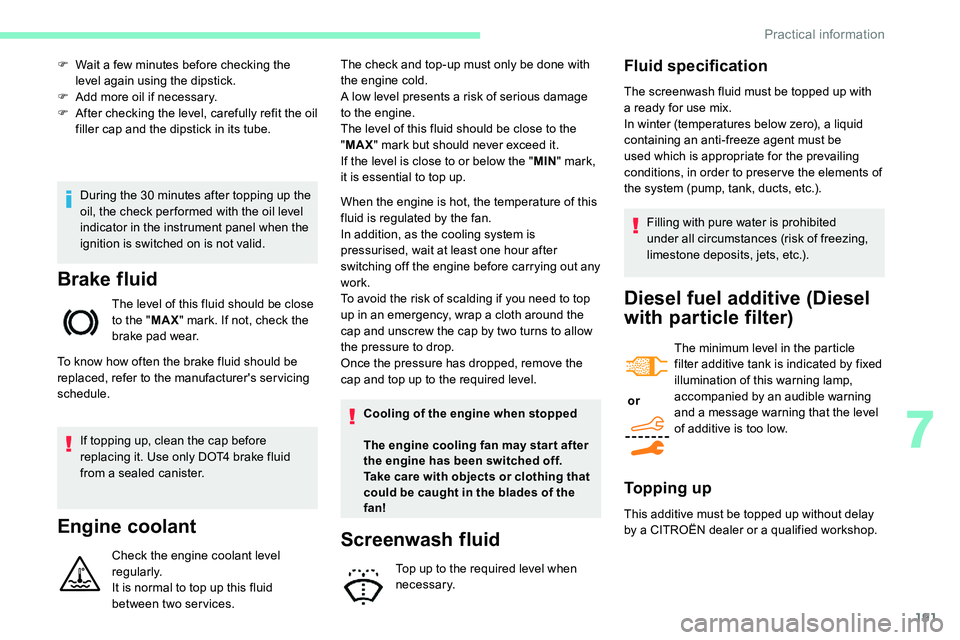
191
During the 30 minutes after topping up the
o il, the check per formed with the oil level
indicator in the instrument panel when the
ignition is switched on is not valid.
Brake fluid
The level of this fluid should be close
to the " MAX" mark. If not, check the
brake pad wear.
To know how often the brake fluid should be
replaced, refer to the manufacturer's servicing
schedule.
Engine coolant
Check the engine coolant level
regularly.
It is normal to top up this fluid
between two services. The check and top-up must only be done with
the engine cold.
A low level presents a
risk of serious damage
to the engine.
The level of this fluid should be close to the
" MAX " mark but should never exceed it.
If the level is close to or below the " MIN" mark,
it is essential to top up.
When the engine is hot, the temperature of this
fluid is regulated by the fan.
In addition, as the cooling system is
pressurised, wait at least one hour after
switching off the engine before carrying out any
work.
To avoid the risk of scalding if you need to top
up in an emergency, wrap a cloth around the
cap and unscrew the cap by two turns to allow
the pressure to drop.
Once the pressure has dropped, remove the
cap and top up to the required level.
If topping up, clean the cap before
replacing it. Use only DOT4 brake fluid
from a sealed canister.
F
W
ait a
few minutes before checking the
level again using the dipstick.
F
A
dd more oil if necessary.
F
A
fter checking the level, carefully refit the oil
filler cap and the dipstick in its tube.
Cooling of the engine when stopped
The engine cooling fan may star t after
the engine has been switched off.
Take care with objects or clothing that
could be caught in the blades of the
fan!Screenwash fluid
Top up to the required level when
necessary.
Fluid specification
The screenwash fluid must be topped up with
a ready for use mix.
In winter (temperatures below zero), a liquid
containing an anti-freeze agent must be
used which is appropriate for the prevailing
conditions, in order to preser ve the elements of
the system (pump, tank, ducts, etc.).
Filling with pure water is prohibited
under all circumstances (risk of freezing,
limestone deposits, jets, etc.).
Diesel fuel additive (Diesel
with particle filter)
or The minimum level in the particle
filter additive tank is indicated by fixed
illumination of this warning lamp,
accompanied by an audible warning
and a
message warning that the level
of additive is too low.
To p p i n g u p
This additive must be topped up without delay
by a CITROËN dealer or a qualified workshop.
7
Practical information